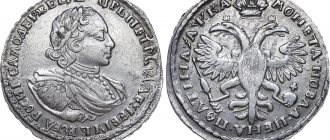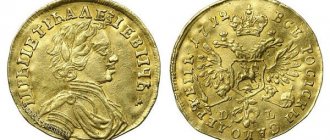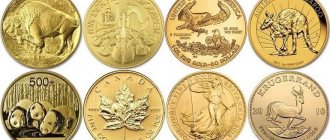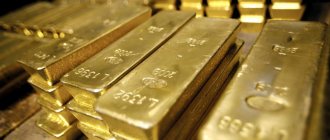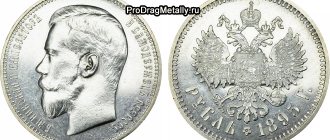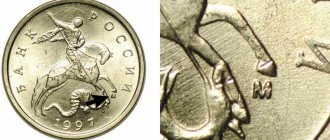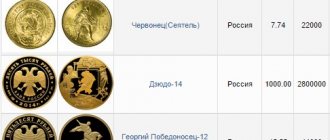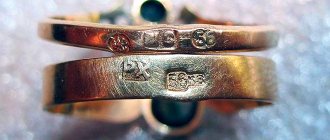The history of coinage and monetary circulation is studied by an auxiliary historical discipline - numismatics. Numismatic collecting - the systematic collection of coins - should be distinguished from numismatics as a science. Of great interest to numismatists are, among others, Russian gold coins, minted over the centuries, starting from the Old Russian state. Among them are the “zolotnik” (zlatnik) of Prince Vladimir, the “shipman” of Prince Ivan III, “Ugric” coins, the golden “wedding book” of False Dmitry I, “Novgorodka” of Vasily Shuisky. Later, the Romanovs (from Mikhail to Peter) minted chervonets, half-chervonets and quarter-chervonetsy.
Development of coinage
Starting from the 9th century, imported money was used in Rus'. For a short period in the 10th-11th centuries, gold and silver coins were minted. There were also silver bars called hryvnias.
In the XII-XIV centuries, Rus' did not have its own coin; this was the period of the Tatar-Mongol yoke, when a significant share of the precious metal went as tribute. From the end of the 14th century, Rus' carefully began producing its own coins - small and lightweight “scales” (they can be considered a prototype of future kopecks). The scales did not have a constant standard weight. Russian princes, and later tsars, constantly reduced their mass in order to save on consumable material. Often, to determine the true value, scales were paid by weight.
Tsar Ivan III issues his own gold coins, but these are not means of payment, but award signs (medals). Their appearance is similar to money: on one side there is a portrait of the sovereign, on the other - a double-headed eagle.
The centralized minting of banknotes began in the 16th century by John IV (the Terrible). He brought the scales to a single pattern, but they noticeably decreased in weight.
Over time, attempts are being made at monetary reforms, the goals of which are to enlarge coins, as well as introduce the use of copper and gold for their minting. Gold money and kopecks (“Novgorodki” and “Moscow coins”) of Vasily Shuisky appeared - 1610, silver rubles and copper kopecks, altyns, pennies of Tsar Alexei Mikhailovich - 1654, silver “Efimki with a sign” (countered on Western European thalers) - 1655
Monetary reform of Peter the Great
In pre-Petrine times, the ruble was not a means of payment, but only a unit of account. During the reign of Tsar Peter Alekseevich Romanov, their own rubles and chervonets appeared in circulation. The word “ruble” comes from the verb “to chop” (they chopped part of the silver hryvnia). The stump of the hryvnia - the ruble - has been used as a monetary unit since the 13th century.
Peter the Great managed to successfully carry out financial reform, the result of which is noted:
- introduction of industrial (machine) coin production;
- consolidation of banknotes;
- the emergence of the ruble as a monetary rather than a unit of account;
- clear equation of 100 kopecks to 1 ruble;
- minting of gold chervonets.
The first regular gold coins of the Russian Empire - chervonets - were issued in 1701 in the amount of 118 pieces. There is only one known copy of Peter the Great's chervonets in gold (issued in 1706), on which the date is indicated in letters. It is kept in the Vienna City Museum. However, according to other versions, similar specimens exist in varying states and are kept by private Russian collectors.
Traditionally in Russia, large gold coins of foreign and domestic production were called chervonets due to the reddish tint of the metal inherent in the material of high standard (“chervonnoe gold”).
Peter I adopted a lot from the enlightened Dutch and, applying new knowledge in practice, introduced coins very similar to Dutch ducats. But the very first chervonets, issued by the great reformer in 1701, were copied from the Hungarian ducat (Ugric, Ugric gold) in full compliance in weight (3.47 g) and gold purity (986).
The denomination on these coins was not indicated, but the gold chervonets circulated in Peter’s times as 2 rubles 30 kopecks. They were minted from 1701 to 1716. It was not very convenient to use them, because two rubles at that time was a significant amount, so they were not popular among the people. In addition, a “double chervonets” was minted, its mass was 6.94 g.
Since 1718, chervonets were replaced by 2 gold rubles. The denomination is almost the same, but the purity is lower. They already have a clear inscription of the denomination.
Gold standard of Paul I
In 1796 and 1797 the emperor issues chervonets (3.49 grams). Since 1898, only five-ruble notes (6.08 grams) have been minted. An interesting fact is the leveling of the sample and its return to high standards (986th). With such purity, the total weight of the five-ruble note (6.08 g) was almost equal to the weight of the precious metal in it (5.99488 g). Paul became the first emperor to prohibit the minting of his portrait on coins. Therefore, on the obverse of the early chervonets a double-headed eagle is stamped. On all other gold coins, the obverse is occupied by the cross-shaped monogram of the autocrat. The reverse for all coins looks the same, containing in a square frame an abbreviated quotation from Psalm 113: “Not to us, O Lord, not to us, but to Thy name give glory, for the sake of Thy mercy, for the sake of Thy truth.” After Paul I, the minting of chervonets in the Russian Empire ceased.
Minting money under Catherine II
Guided by the example of Peter the Great, each of the subsequent emperors considered it necessary to mint coins with their own portrait. The only exception was Pavel I, whose appearance was not pleasant. On the money from the period of his reign, instead of a portrait, a cross and a text inscription were depicted. During the time of Paul I, two varieties were issued in gold: chervonets and 5 rubles.
The reign of his mother, Empress Catherine II Alekseevna, is characterized by great diversity and activity in the coin business. Such coins were minted under her.
- From silver: 1 ruble, fifty kopecks and half-fifty kopecks, as well as kopecks - 20, 15 and 10 (kopeck pieces).
- From copper: 1, 2, 5 kopecks, denga and half.
- — From gold: half, 1, 2, 5, 10 rubles, 1 chervonets.
It is known that the 1 ruble gold coin was not popular among the people, so it was minted mainly for palace circulation. Gold money of Catherine II was issued in St. Petersburg in small editions in different years from 1762 to 1796. The Moscow Mint was not involved in such production. The most common is the royal coin with a face value of 5 rubles.
The Russian denomination is not indicated on Catherine's chervonets; they were intended for foreign trade. The value of such a coin was determined by the value of the precious metal from which it was made. The mass (3.47 g) and fineness (986) of Russian chervonets remain virtually unchanged throughout history from Peter I to Nicholas II.
During the long reign of Catherine II, portraits on coins issued under her changed in accordance with the transformation of the empress's appearance. On the chervonets of the third issue of Catherine's era (1796), the Empress is depicted with a shorter neck and a massive chin. The portraits in the first two issues differ in the details of their outfit: in 1763, Catherine with a scarf, in 1766, without.
From 1766 to 1781, Catherine the Great minted “Siberian coins”, made at the Suzunsky Mint from special copper containing impurities of silver and gold. It was mined at the Kolyvan mines and designated by the letters KM (Kolyvan copper).
During the same period, trial copies of the Sestroretsk copper ruble of unusual design were produced. Its weight is 1 kg, diameter is 76 mm, height is 35 mm. Due to difficulties that arose, its production was suspended; mass minting was never established.
Gold coins of Tsarist Russia from the reign of Catherine II are of great interest to collectors, given the many rare varieties. There are Catherine gold rubles with a narrow and wide portrait of the Empress, with a more convex coinage, with an inverted letter “P” in the designation S.P.B. (St. Petersburg Mint). All these rarities increase the value of ancient coins.
Coins and Sestroretsk ruble
Even under Peter I, large deposits of copper were found in the Urals, but due to the inaccessibility of the region, their development had to be postponed. In 1723, Yekaterinburg was founded (named in honor of Catherine I, the wife of Peter), where large metallurgical plants were built, including the “toll yard” - an enterprise for the production of Swedish-type toll coins. In Sweden in the middle of the 17th century, multi-kilogram rectangular copper boards with stamps on the corners were produced; they had a denomination in dalers and replaced silver in monetary transactions; they intended to introduce something similar in Russia. Square coins were issued in 1725-1726 in units of 10 rubles per pood, and had the following denominations: 1.5 kopecks, hryvnia (10 kopecks), half a half (25 kopecks), half a half (50 kopecks) and ruble. On large ones (starting with the hryvnia) there were 5 round stamps: four eagles in the corners and the denomination in the center. On the kopeck and 5 kopecks there was only one stamp with an eagle, and the denomination was indicated on the sides. On the reverse side of all the boards there were no images or inscriptions, but hryvnias with letters - the initials of the mintzmeister - are known. It soon became clear that heavy fee coins were inconvenient to handle, and the population was reluctant to accept them. Therefore, in 1727, the yard was renamed a mint and began producing first blanks and then coins, becoming the largest enterprise for the production of copper coins. After the introduction of paper banknotes, the need arose to provide them with coins. Minting nickels was a difficult task and required large resources. Therefore, we decided to return to the idea of issuing copper rubles; fortunately, by that time the ruble had “lightened” from 1.6 to 1 kg. It was planned to start production at the Sestroretsk plant from former cannon barrels. The stamps for minting had the diameter of a silver ruble, and the copper ruble itself was much larger - about 7 cm and 2.5 cm thick. Circles were made by sawing a copper cylindrical billet, and attempts were also made to make them by casting. The complexity of the production of Sestroretsk rubles did not justify itself and all initiatives were shelved. Several test specimens have survived, one of which has a diameter of 101 mm and a thickness of 15 mm. Numerous fakes and imitations of later times are also known, differing in the quality of the blanks and designs. Many of them still baffle collectors. Among the strange followers of the Sestroretsk ruble is the so-called “Pugachev ruble”, minted on ordinary silver, but with Sestroretsk stamps. Its purpose is still not clear, and the name “Pugachevsky” was given by the date “1771” on it - the year of the Pugachev uprising. Top
Varieties of metal money of Nicholas II
During the reign of the last Russian Tsar Nicholas II Alexandrovich, more than two dozen types of coins were issued, half of which were made of gold. Silver and copper money and even 5 rubles were also minted from aluminum (trial version). In gold version, 5, 7.5, 10, 15, 25 rubles are known.
From 1895 to 1897 the mint minted semi-imperials and imperials (imperial or imperial Russian gold coins). During this period, the semi-imperial corresponded to five gold rubles, the imperial - ten. The first were produced in 36 pieces annually, the second in a slightly larger circulation: 125 copies per year. This suggests that these imperial banknotes were not intended for mass circulation.
Meanwhile, a monetary reform was carried out in the state, prepared by the Minister of Finance Sergei Yulievich Witte. It assumed a transition to gold monometallism (when the monetary system is based on one metal, in this case gold). This is a system in which there is free circulation, issue and exchange of gold coins for other types of banknotes. At the same time, the ruble was devalued, and the price of the imperial rose from 10 to 15 rubles (since 1897).
In order to distract the population from reducing the price of the ruble by a third, Nicholas II wanted to replace the monetary unit with a new one - Russian. In accordance with the imperial decree, a trial batch of gold coins was produced in denominations of 5, 10 and 15 russ (respectively: a third, a half and a full imperial). The matter did not reach mass production, the sovereign did not like the new money (inconstancy is considered one of the character traits of Nicholas II), and Witte’s financial reform was carried out without changing the name of the currency.
New imperials and semi-imperials are minted with denominations in rubles - 15 and 7.5, respectively. Otherwise, their design is completely identical to its predecessors. This happened only in 1897, but 15- and 7.5-ruble coins are not rare, because they were issued in large editions: the first - 12 million pieces, the second - 16 million.
From 1898 to 1911 In the Russian Empire, gold five-ruble notes and chervonets (10 rubles) are produced in large quantities. The five-ruble coin is now no longer a half-imperial coin, but only a third of the main imperial monetary unit. They are similar in design, but the weight is reduced: 4.3 g (against the previous 6.45 g), the pure gold in it is 3.47 g (in the semi-imperial it was 5.8 g), the diameter is also reduced from 21.3 mm to 18.5 mm due to narrowing of the edge.
Golden Nikolaev chervonets also lost in weight, mass of pure gold and size compared to the imperial:
| Title and date | Diameter, mm | Weight, g | Weight of pure gold, g |
| Imperial 1895–1897 | 24 | 12,9 | 11,61 |
| 10 rubles 1898–1911 | 22 | 8,6 | 7,74 |
Since 5- and 10-ruble coins were issued in huge circulations at that time - several million copies per year - they are very common now, but there are exceptions: rare royal gold chervonets of 1906, for which several tens and even hundreds of thousands of dollars. That year, only 10 coins of 5 and 10 rubles were minted.
Twice during his reign, Nicholas II issued commemorative (gift) coins of 2.5 imperials (25 rubles): in 1896 - in honor of his coronation and in 1908, timed to coincide with his 40th anniversary. In both cases, by analogy with the imperial, a double-headed eagle is depicted on the obverse, and a portrait of the autocrat is depicted on the reverse. All parameters were increased: diameter: 33.5 mm, weight - 32.26 g, pure gold - 29.03 g. The second issue caused financial confusion, because during this period one imperial was no longer equal to 10, but 15 rubles, but there was a lot of damage did not harm the market: the circulation of commemorative coins in each issue was only 175 pieces.
In 1902, another 235 Nicholas gold coins of 100 francs or 37.5 rubles were issued, repeating the design and weight (with a larger denomination) of the 1896 gift 25-ruble coin.
What is on the money?
- The front side was a portrait of the ruler and two phrases around him.
- Size – 21.3 mm.
- Gold per coin – 5.8 grams.
- On the edge there is a phrase - “Pure gold 1 spool 34.68 shares (A.G.).”
The royal 5 rubles are quite rare, so their value can reach 150-200 thousand dollars. At the same time, it is observed that the price is rising every year.
In Ukraine it reaches 5,200,000 hryvnia. Also, the condition of the semi-imperial may affect the amount offered: if it is perfect, the coin will be sold at a higher price.
Historical and market value of individual specimens
Even at the turn of the 10th-11th centuries, Prince Vladimir minted “zolotnik” (or “zlatnik”). Only 11 copies of this first ancient Russian gold coin have been found. The only copy of the “shipman” - the medal of Ivan III Vasilyevich, minted between 1471 and 1490 - is kept in the Hermitage. The golden chervonets of Peter I remains desirable for many collectors. These rare specimens at auctions reach prices of up to several hundred thousand dollars, depending on their condition and year of issue.
Almost each of the subsequent sovereigns of the Russian Empire printed rubles, chervonets or imperials from gold. From 1828 to 1845, during the reign of Nicholas I, “white chervonets” were issued, now classified as numismatic rarities. During a period of acute shortage of precious metals, the idea arose of producing coins from platinum, which was mined in large quantities in the Urals. The denomination indicated on them is interesting: “3 rubles for silver.” Soon “6...” and “12 rubles for silver” appeared. On the obverse is the coat of arms of Russia: an eagle with two heads. They were 97% pure platinum. One of the first test copies of the “white chervonets” has been preserved; it is exhibited in the Hermitage (St. Petersburg).
The preserved Rus of Nicholas II are highly valued (about 500 thousand dollars at auctions). There are only five sets of them. The owners of three of them are museums in Russia (the State Historical Museum and the Hermitage) and the USA (the Smithsonian Museum). Another set is in a private collection. The fate of the fifth is unknown. According to one version, it was divided into separate coins and sold to different collectors.
At all times, and especially now, coins of the Russian Empire arouse interest and are in considerable demand among both domestic and foreign numismatists. Not too many examples of imperial coinage art have survived to this day. After all, the money of those times was printed from pure metals with a small amount of impurities, so over the years they were often melted down or used to make jewelry. With particular interest, collectors “chase” gold rarities that were produced purely for palace use. In modern times, they can be found in single copies, which makes them very expensive at auctions.
But it’s not only the high market value of ancient coins from Tsarist Russia that inspires admiration. Imperial coin production, starting from the reign of Peter I and until the tragic end of the reign of Nicholas II, gave the world magnificent examples of monetary circulation - real works of art created by masters of their craft.
